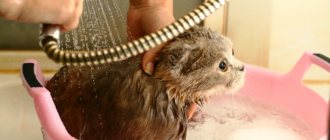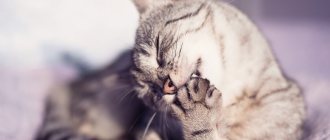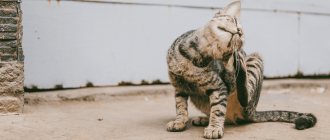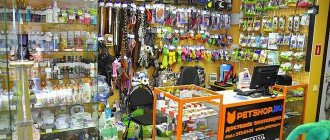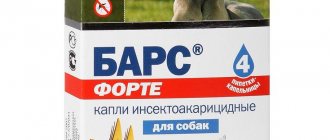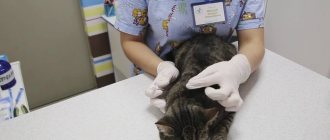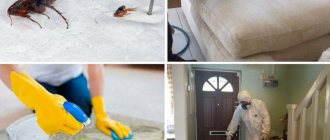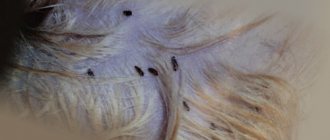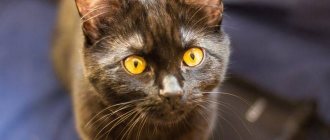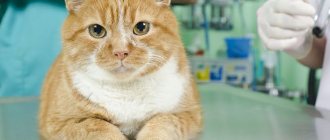Not a single decent, sedate and homely cat is immune from flea infestation, not to mention those that like to walk on their own. But these small blood-sucking insects not only cause pets a lot of anxiety and inconvenience, but are also carriers of various diseases and worm eggs. Therefore, the fight against them must begin immediately, as soon as the animal begins to itch intensely and show signs of nervousness and anxiety.
- 2 Flea shampoos: composition and method of action on parasites
2.1 Video: how flea shampoos work
- 4.1 Photo gallery: anti-flea shampoos for cats
- 5.1 Photo gallery: anti-flea shampoos for kittens
- 6.1 Video: washing your cat with anti-flea shampoo correctly
- 9.1 Video: how to get rid of fleas in the house
The main criteria for choosing flea shampoo for cats
When choosing an antiparasitic detergent for cats, consider 5 factors:
- Age of the animal. Small kittens need specialized products that are less toxic.
- Purpose of application. In case of severe infestation, more effective insecticide-based preparations are used for treatment. For preventive purposes, gentle products, which are dominated by natural soft ingredients, will be sufficient.
- Pet's condition. Sick or weakened animals, as well as pregnant and lactating cats, require more careful treatment.
- Features of the coat. There are special means that take into account the length of the coat or its complete absence.
- Shelf life.
To make an informed decision, it is better to consult a veterinarian who will help you choose the right product.
For small kittens you need to select a special shampoo
How to wash a cat if there is no special shampoo
For regular care of animals, special products are needed. They are less aggressive in composition than regular shampoos. It is best to wash the cat with warm water and beaten egg yolk. If that doesn’t work, you need compounds with PVA.
In rare cases, you can wash cats with regular shampoo or soap, but it is not advisable to do this often. The animal's skin will begin to peel off.
Let's discuss what to choose from what is in the bathroom.
Regular soap
It is not recommended to bathe a kitten with soap with a strong fruity or floral aroma. Bath, pine, and baby soap are preferable. Experienced veterinarians do not advise excessive soaping of the animal.
It is enough to pour it with soapy water or apply foam to the wool. If the surfactants (surfactants) don't touch the skin, great.
You shouldn't bathe your pet too hard. He must have natural protection.
Baby shampoo
Products used to wash children under three years of age are hypoallergenic. They contain less of all kinds of synthetic additives and more natural ingredients. But you can’t get carried away with them either.
The product is pre-diluted 1:3 and foamed well. And then the kitten is treated with foam. You need to carefully clean the face.
Phrases like “washes without tears” are a marketing ploy. When foam gets into the eyes of animals, conjunctivitis develops. The small pet will become restless. Ears are a no-go area. They are cleaned with ear sticks with water, lotion or saline solution.
Regular human shampoo
Some owners use human shampoo to care for their pets, and do this regularly. Veterinarians strictly prohibit doing this. The secretion of fatty glands is disrupted, the skin suffers, and the structure of the hairs changes.
Allergic dermatitis and other skin diseases are possible. Immunity weakens. After washing, cats get sick more often and can get pneumonia.
If there are several hair care products, choose the simplest one. It is better if it contains a decoction of herbs, without dyes or thickeners.
The soap composition is made by diluting the shampoo with water, increasing the volume at least five times. In this case, it will be possible to protect the cat from the consequences and reduce the risk of developing skin diseases.
Tar shampoo or liquid soap
Tar is an excellent folk remedy for skin irritation. Liquid soap or tar shampoo is a good insecticidal remedy for blood-sucking insects.
If your pet constantly scratches itself with its paws or bites something out of its fur, it may have fleas. Try washing it with tar soap. This primitive method is used in folk medicine.
Flea shampoos: composition and method of action on parasites
Anti-flea detergents for cats include the following components:
- foaming agents (surfactants);
- decoctions of medicinal herbs (plantain, celandine, coltsfoot, etc.);
- nutritional and caring components;
- essential vegetable oils (citronella, lavender, cloves, etc.);
- insecticides that have a detrimental effect on fleas: synthetic pyrethroids (cypermethrin, phenothrin, permethrin, decamethrin, etofenprox and others);
- natural pyrethroids or similar ones obtained from natural raw materials (pyrethrin contained in the flowers of Caucasian, Persian or Dalmatian chamomile).
A paralyzed flea dies quickly
When the active substance enters the insect's body through the protective chitinous cover, the permeability of nerve cell membranes is disrupted. As a result, the passage of the nerve impulse is blocked, and the paralyzed flea dies after a few minutes. The toxic substance is equally effective on adult insects, eggs and larvae.
Preventive flea shampoos do not contain toxic substances, but are limited to repellent components - extracts of tansy, tea tree, burdock, wormwood and other plants.
Video: how flea shampoos work
Mechanism of action of insecticidal shampoo
Let's look at how flea shampoo works. The insecticide included in the composition has a contact and intestinal effect. Penetrating inside the insect, it disrupts the balance of acetylcholine and activates acetylcholinesterase. As a result, the neurotransmitter does not connect to the dendrite receptors, the signal is blocked and the muscle fibers literally “freeze” in a compressed state. A paralyzed insect dies within a few minutes. For a more complete effect, the instructions recommend leaving the flea shampoo for cats on the animal’s fur for 5-7 minutes.
When choosing a product, you should pay attention to concentrated detergents, which are much more economical to use, have better contact with the coat, are richer in composition, and the treatment of your pet’s “fur coat” with their help is better.
Flea shampoo is an “ambulance” product that can rid your furry pet of parasites in one use. Therefore, it is worth taking the one with a longer shelf life. A concentrated, effective shampoo, even if used to prevent infection, may simply go bad.
It is worth reading the instructions, because shampoo intended for washing fluffy cats cannot be used to care for smooth-haired or hairless felines. They have different numbers of sweat and sebaceous glands in their skin. Those shampoos that are suitable for sphinxes will dry out the skin of Persians.
Flea shampoo for kittens
Anti-flea shampoo for kittens is appropriately labeled, contains a smaller amount of insecticide, a more gentle composition and special additives that care for the kitten’s delicate skin. Intended for washing an adult cat, it can cause poisoning in a baby.
On a note!
The cat should not be washed too often. Excessive grooming not only damages the fur and skin of your mustachioed pet, but also deprives him of a substance that is very important for mental health, which the cat licks from its fur when “washing”. Scientists say that if a cat is not allowed to toilet, it may die. Cats have a very delicate mental organization. Severe stress can undermine the health, psyche and lead to the death of the animal. Therefore, when bathing your pet, try not to traumatize its mental state - talk to the pussy, do not plunge a resisting animal into water.
Whether shampoo against fleas helps cats is determined by each animal owner himself. But if you choose the right product and follow the instructions, the result will not be long in coming.
Types of flea shampoos
Anti-flea detergents for cats are divided into two groups:
- Therapeutic (aggressive). Such shampoos contain active ingredients - insecticides. The products are intended for treating animals to kill parasites.
- Preventive (non-aggressive). These shampoos are regularly used to prevent fleas from infesting your pet. They contain non-toxic ingredients.
According to the form of release, zoo shampoos are:
- liquid - ordinary detergents of liquid consistency;
- dry - a fine powder, reminiscent of powder, which is generously sprinkled on the animal’s fur, and then be sure to comb it out thoroughly.
There are a lot of different flea products and shampoos available in stores.
How to make shampoo with your own hands?
In addition to purchased products, homemade formulations are widely used when removing fleas. If you decide to make your own shampoo, take:
- baby soap (1 bar);
- water (2.5 cups);
- onions (1 piece);
- the yolk of one chicken egg;
- infusion of nettle or wormwood (1 teaspoon).
To prepare the composition you need:
- grate the soap;
- combine soap with water and simmer over low heat;
- after the solution reaches a jelly-like state, add chopped onion;
- mix everything and add the herb infusion and yolk;
- mix everything thoroughly again.
The shampoo is ready! We lather the animal's fur as usual and leave it on for 10-15 minutes, after which we rinse it off with warm running water.
Table: comparative characteristics of different types of flea shampoos
| Name | Active substance | Additional Impact | Purpose of application | Use for kittens | For pregnant and lactating cats, as well as weakened or sick animals | Price |
| Leopard |
|
| prevention | allowed | not intended | 180–200 rub. |
| BioVax |
|
| prevention | from 1 month | allowed | 100–140 rub. |
| Celandine |
|
| treatment and prevention | from 8 weeks | not allowed | 110–130 rub. |
| Lugovoy |
|
| treatment and prevention | From 12 weeks | forbidden | 160–200 rub. |
| Doctor Zoo |
|
| prevention, treatment with repeated use | allowed | allowed | 120–140 rub. |
| Ms.Kiss (Miss Kiss) | permethrin (0.5%) |
| treatment | from 4 months | is not allowed | 170–210 rub. |
| Phytoelite |
|
| treatment and prevention | from 2 months | cannot be processed | 90–120 rub. |
| 4 with a tail | citronella oil |
| prevention and short-term protection | from 1 month | permitted with caution | 80–100 rub. |
| BIO-GROOM |
|
| prevention and treatment | from 12 weeks | Not recommended | 1000–1100 rub. |
| Rolf Club |
|
| treatment | from 4 months | prohibited to use | 200–300 rub. |
All pet shampoos against parasites belong to the group of low-toxic drugs (group 4) and are not dangerous to humans.
Photo gallery: anti-flea shampoos for cats
The series of shampoos Four with a tail has a mild preventive effect
BIO-GROOM zoo shampoo has a strong healing effect
Biovax zoo shampoo can be used for kittens from a month of age
Zoo shampoo Doctor Zoo has a therapeutic effect with repeated use Insecticidal shampoo for cats Lugovoy is very popular
Ms.Kiss flea shampoo is inexpensive and effective
Rolf Club flea shampoo is contraindicated for kittens and pregnant cats
The Phytoelite line includes shampoos for cats with different coat types.
Phytoelita shampoo is suitable for cats and dogs
Bars flea shampoo is a preventive product
Insecticidal shampoo Celandine has a positive effect on the condition of the coat due to the content of aloe vera and provitamin B5
What about tar soap in the fight against fleas? Real reviews
Important!
Birch tar from which tar soap is made has no insecticidal properties. However, this does not prevent the use of soap to combat fleas in cats.
Soap really helps, but it does not kill lice, but repels them with its smell; in addition, the product has a positive effect on the animal’s skin, eliminates itching and promotes the healing of small wounds.
If you just scare away the insects, then after a while they may just as well come back. That is why the effect when using tar soap is observed only with repeated use.
If we compare soap with other products in the form of shampoos, drops and sprays, then soap is ineffective in removing fleas, but it helps very well when insecticidal drugs are contraindicated for an animal (for example, due to allergies).
Flea shampoos for kittens and pregnant animals
Since all antiparasitic pet shampoos are toxic to a certain extent, they can be safely used only for adult and completely healthy animals. Small kittens, sick and weak pets, as well as pregnant and lactating women should not be washed with such preparations. For this category, special gentle and non-toxic anti-flea detergents have been developed:
- Celandine for puppies and kittens - mild caring insecticidal shampoos with lavender essential oil, their use is recommended for animals from 8 weeks of age;
- Four with a tail - pet shampoos from this manufacturer are safe for kittens after a month of life, as well as for lactating and pregnant cats;
- Phytoelita insecticidal for kittens is a safe natural anti-flea detergent based on an extract of celandine and wormwood;
- Doctor Zoo for kittens is an insecticidal natural well-foaming detergent made using essential oils and herbal extracts, approved for pregnant cats, weak animals and kittens from the third week of life;
- insecticidal shampoo for kittens Gamma - suitable for babies from 8 weeks.
Photo gallery: anti-flea shampoos for kittens
Zooshampoo Gamma can be used for kittens from the third month of life
Good Cat anti-parasitic shampoo for kittens against fleas will help remove parasites and make the coat soft and silky. Dana shampoo belongs to the group of insecticidal preparations with contact action.
Doctor Zoo insecticidal shampoo for kittens is made from natural ingredients
Insecticidal shampoo for kittens Phytoelita is made on the basis of decoctions of celandine and wormwood.
Zoo shampoo Celandine for kittens and puppies contains lavender oil
All insecticidal shampoos intended for kittens can be safely washed by pregnant and lactating cats.
Video: how to remove fleas from a small kitten
Advantages and disadvantages of using anti-flea shampoo
The undoubted advantages of liquid flea products include:
- versatility - suitable for cats of all breeds;
- low toxicity;
- ease of use;
- efficiency - fleas die on the second day maximum;
- low cost;
- no side effects;
- positive effect on wool quality.
The disadvantages include the following:
- the possibility of allergic reactions to some components;
- short period of protection (no more than 20 days);
- cheap products are ineffective, and high-quality shampoos are much more expensive;
- Some cats cannot stand water treatments, so shampoo cannot be used.
If our cat suddenly has fleas, we always wash her first with a special anti-flea shampoo, and then put on a protective collar to avoid re-infestation.
Contraindications and side effects
A clear contraindication to the use of pet flea shampoo would be individual intolerance to any components and the animal’s violent reluctance to undergo water procedures. A side effect may be intoxication caused by the detergent entering the digestive or respiratory tract, as well as the accumulation of toxic substances due to too frequent use.
If there are strong signs of poisoning (vomiting, weakness, drooling, etc.), you should immediately consult a veterinarian.
Some cats are categorically against water procedures
Safety rules when treating cats with shampoo
When treating an animal with flea shampoo, the following rules must be observed:
- first carefully study the instructions, act strictly according to them and strictly follow the dosage;
- to prevent water from entering, the cat’s ears can first be plugged with cotton tubes soaked in vegetable oil;
- thoroughly rinse the product from the fur and under no circumstances allow the animal to lick itself;
- do not bathe your pet too often.
The instructions must be read very carefully and the recommendations in it must be followed exactly.
Video: how to get rid of fleas in the house
Instructions for use
Each flea shampoo has features that include rules of use. Before using the product, be sure to study the instructions, determine the dosage and procedure.
How to treat an animal with soap?
How to wash a cat is decided by the owner, focusing on the character of the animal, its attitude towards the washing process, and aggression. Several recommendations will help make the process more comfortable for both parties and more effective:
- the water should be slightly warmer than room temperature;
- the water level in the tub or basin should reach approximately the animal’s stomach;
- the wool should be moistened generously with water without touching the head;
- the shampoo is applied to the back and washed thoroughly, distributing it throughout the body, then you need to wait the time specified in the instructions;
- The product must be thoroughly rinsed with plenty of water (preferably in the shower).
After washing, the animal must be combed to remove dead insects, eggs and larvae.
Frequency of the procedure
Do not wash your cat too often with medicated flea shampoos, as the insecticidal chemicals contained in them can gradually accumulate in the body, causing intoxication and, in addition, negatively affecting the condition of the coat.
Simply wash your cat once to get rid of fleas. In a neglected condition, shampoo can be reused 5–7 days after the first wash. But after this you need to take a break for 2 months.
Herbal shampoos contain natural ingredients, so they can be used without fear for the cat’s health. Preventive shampoo can be used every 10-15 days, but in general the frequency depends on the duration of the product.
How long does the effect last after using the drug?
Medicinal shampoos act immediately, fleas die after washing. The effect of phytoshampoo can last from 8–10 hours to 2–3 weeks after bathing. It all depends on what ingredients are included in the product and in what concentration.
What is recommended to combine anti-flea shampoo treatment with?
To enhance the effect, the use of shampoo is often combined with the use of other antiparasitic agents.
May be:
- flea drops;
- spray;
- flea collar.
Usually the scheme is as follows: first the cat is washed, then flea drops or sprays are applied or a collar is put on. It is advisable to consult your veterinarian before combining funds. Some drugs can mutually enhance the toxic effect of each other, which will lead to intoxication of the animal.
